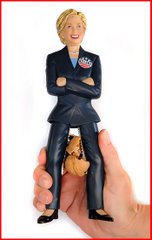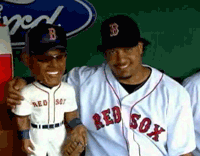COLUMBIA'S REACTION TO ANTI-SEMITISM ON CAMPUS
Calm Down, It's Only a Swastika (WSJ-BOTW)
This week saw a pair of ugly incidents at Columbia University. On Tuesday, somebody hung a noose from the doorknob of a professor's office at Teachers College, Columbia's education school. Yesterday an anti-Semitic graffito was found in a men's room at Lewisohn Hall, home of Columbia's School of General Studies.
In both cases Columbia's president, Lee Bollinger, sent a mass email to members of the "Columbia community." A source from within that community forwarded those emails to us, and they make for a fascinating contrast.
Here is Bollinger on the noose incident:
As most of you now know, a terrible incident of bias occurred at Teachers College yesterday, directed at a member of the faculty. Teachers College is a cherished affiliate of Columbia University with its own president, Susan Fuhrman, to whom I have offered our support and assistance. We may be two independent institutions, but we are one community; and we stand together in our commitment to oppose the frightening sentiments that lay behind this act.
Tolerance and mutual respect are among the core values of our diverse community, and all of us must confront acts of hate whenever they occur within it. As I said last night, an attack on the dignity of any member of our community is an assault on all of us.
I will be meeting with student leaders this afternoon, and other members of the administration will be communicating with faculty and students in the coming days. Our mission as a university includes addressing the most important and searing issues of our time, and we have a particular obligation to respond forcefully to events that affront our values.
And here is Bollinger on the graffito:
I am saddened to report that one of the bathrooms in Lewisohn Hall was sullied with an anti-Semitic smear. It has been promptly removed and is now being investigated.
I want to make two points. When words are the offender, as in this incident, I am reluctant to draw attention to them and will exercise restraint in doing so going forward. I do not want to broadcast, in any way, the message they attempt to send or empower those behind them. Despite the irrational, destructive hatred that persists in our society and world, we do not accept this anywhere at this University. No one among us should feel marginalized or threatened by words of hatred. We are one community; and as one community, we will overcome these hateful acts and hold each other to the highest standards of respect for the dignity and diversity of every individual.
In response to questions students have raised, I also want to reassure you that we have utmost confidence in our Public Safety officials and in the NYPD. Not only do they have well established communications protocols in place when there is an immediate threat of harm; they distinguish crimes that threaten our physical safety from incidents like the one that occurred today.
What accounts for the differences in tone and substance between these two letters--expressing unambiguous outrage in the first incident, while urging restraint in the second one?
Although this second email does not mention the noose incident, it seems clear that Bollinger is trying to distinguish the rest room incident from it when he says that in the latter, "words are the offender," and that the police "distinguish crimes that threaten our physical safety from incidents like the one that occurred today."
The first of these distinctions rests on a factual error. The Village Voice quotes a police report's description of the graffito: "a caricature of a male wearing a yarmulke above a swastika." (We assume this means the caricature was above the swastika, not that the male was depicted as wearing the swastika.) These cases are alike, then, in that both involve powerful symbols of hatred, not mere words.
What about the distinction between "crimes that threaten our physical safety" and "incidents like the one that occurred" yesterday? As a legal matter, the question of whether the noose constitutes a "true threat" is a very murky one, and one that depends in substantial part on the motives of the person who placed the noose--whose identity apparently remains unknown. One factor that militates in favor of its being a true threat, however, is that it appears to have been directed against a specific person. (We are assuming for the purpose of discussion that neither incident is a hoax.)
But imagine if the situations were reversed. What would Bollinger's reaction have been if the swastika were painted on the door of a Jewish professor's office and the noose turned up in a rest room?
One can only speculate, and we shall do just that. We can imagine that a swastika on a professor's door would draw a stronger reaction from Bollinger than the one in the men's room actually did. But if it were a noose in the rest room, we find it very difficult to imagine such a tepid response.
This is an educated guess based on years of observing how multiculturalism, the regnant ideology in American higher education, works. Multiculturalism conceives of mankind as being divided into various groups (based on race, ethnicity, sex, religion, sexual orientation, etc.) and imposes a complex hierarchy in which an individual's moral authority depends on the degree to which the groups to which he belongs are "oppressed."
The purest form of multiculturalism is what Shelby Steele calls "white guilt." White guilt, of course, has a real and powerful basis in history, as whites actually did oppress blacks, systematically and brutally, for most of American history. White guilt constrains Bollinger against urging blacks to "exercise restraint" in the face of the Teachers College noose. As a person of pallor, he simply lacks the moral authority to second-guess the reaction of blacks to racial offenses.
The relationship between multiculturalism and anti-Semitism is much less black- and-white (in more ways than one). Multiculturalism anathematizes anti-Semitism by white Christians, whether of the Nazi or the country-club variety. But it embraces other forms of anti-Semitism, most notably under the guise of supporting "oppressed" Palestinians against their Jewish putative tormentors.
Bollinger's muted reaction to the Lewisohn Hall episode, we'd venture, is partly a result of not knowing who the culprit was. If it turns out to be a white Christian with National Socialist tendencies, it will be easy to condemn. But what are the odds of finding such a man on an Ivy League campus in 2007? If the vandal is Muslim, or Arab, or black, or a left-wing anti-Israel activist, by contrast, the multicultural moral calculus is much more complicated and must take into account his status as a member of an "oppressed" group.
A final thought: No institution in America has embraced multiculturalism with anything like the ideological fervor of higher education. It's hard to think of any institution in America that is more beset by strife over race and other distinctions among identity groups. Could there be a causal relationship here?























No comments:
Post a Comment